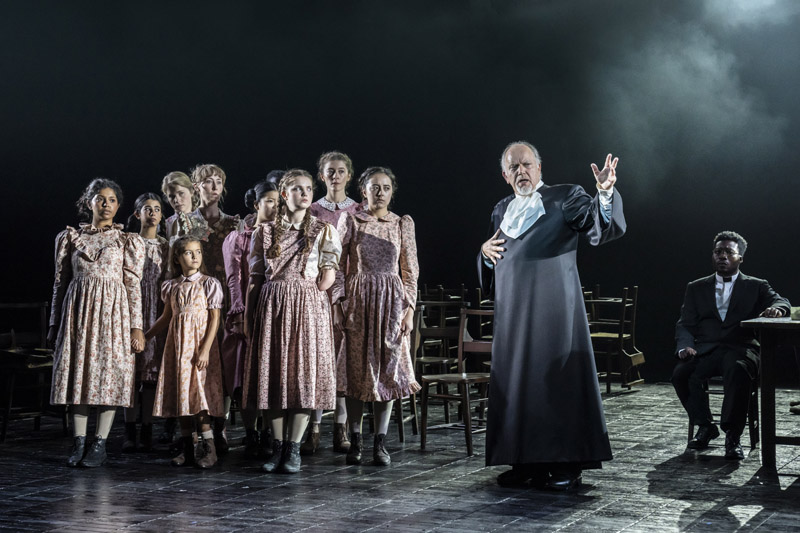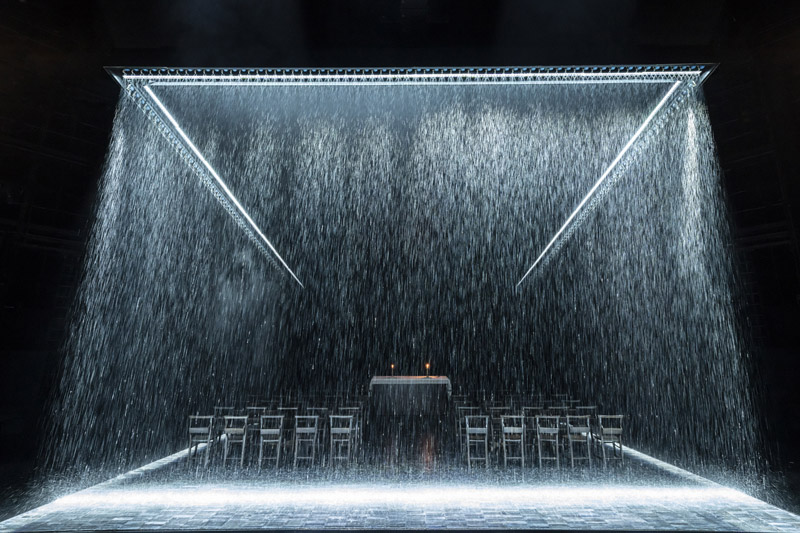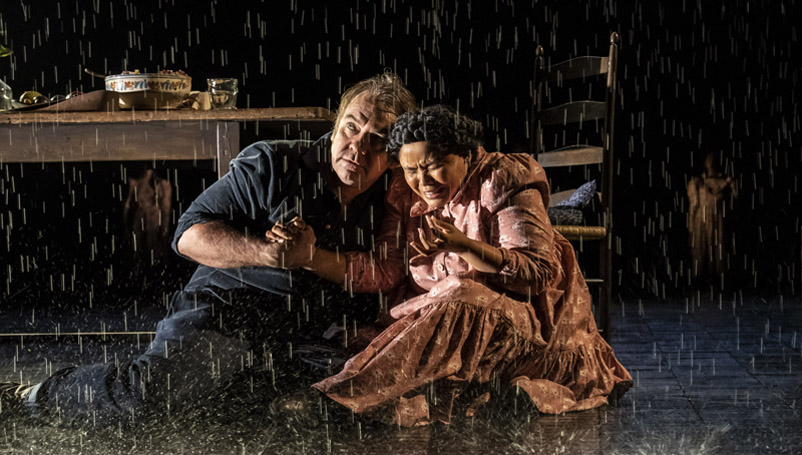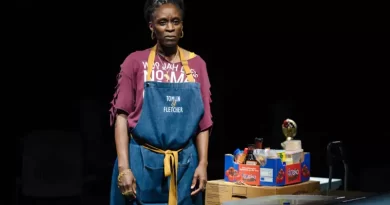“The Crucible”, National Theatre, Olivier
Neil Dowden on the Southbank
2 October 2022
The trials in Salem, Massachusetts in 1692–3 which led to 19 people being hanged for witchcraft have haunted American history. In his 1953 play The Crucible Arthur Miller used the notorious episode as an allegory for Senator Joseph McCarthy’s House Un-American Activities Committee communist witch-hunt in post-war America, of which Miller himself was a victim. Those historical events may have faded with time, but the play is still a compelling dramatization of the dangers of extremism and intolerance – religious or political – causing havoc in a community where individual freedoms are suppressed.

Nick Fletcher and Fisayo Akinade (foreground, right).
Photo credit: Johan Persson.
Lyndsey Turner’s revival at the National avoids the temptation to make any obvious contemporary parallels to the theocratic Salem – though the increasing divisions in our societies offer plenty of choice – in a fairly traditional production that lets the power of this universal, timeless drama hit home.
The intensity of the story is maintained over three hours. After Abigail Williams and other adolescent girls are caught dancing naked in the wood while “conjuring with spirits”, bigoted paranoia and mass hysteria engulfs Salem. The frightened girls are initially forced to point the finger at guiltless adults in order to save their own skins, before a vicious circle of accusations extends through the enclosed town, some in self-defence, some in revenge for petty grievances.
Those like John Proctor who make a stand and refuse to name names are doomed. Once the state authorities become involved in the trials and subsequent executions there is no going back despite evidence of lying in court – any admission that they have killed innocent people could lead to rebellion.
Although Turner’s production is not particularly innovative, it does foreground the girls who are on stage much more than normal, suggesting that the sexual, physical, and social repression they suffer is a big cause behind the enveloping crisis. The girls act as a sort of chorus speaking lines of Miller’s prologue and epilogue intended just to be read, as if they are taking control of the narrative. In a short, added introductory scene of a church service (in which the congregation mechanically gesture in unison while singing a hymn), we see Abigail struck across the face by the pastor for laughing – and later we see similar abuse meted out to the girls whenever they step out of line.

Set design by Es Devlin.
Photo credit: Johan Persson.
All dressed in pinkish pinafores (apart from the slightly older Abigail, the ringleader) they huddle together for mutual support and growing influence, sometimes singing eerily a cappella like supersized dolls in a horror film. Particularly memorable is the chilling scene when – as their new-found authority is threatened – they appear to be suffocated en masse by the spirit of the Proctors’ servant Mary Warren, who is telling the judge they are dissembling but in the end cannot resist their collective force.
Es Devlin’s striking design features – between scenes – a curtain of rainwater on three sides, a hard-tiled floor, a claustrophobic ceiling suspended over the stage, and overturned chairs. Catherine Fay’s costumes are of mixed-period, suggesting the drama’s relevance is not confined to colonial times. Tim Lutkin’s stunning lighting sometimes illuminates vignettes at the back of the deep Olivier stage which are referenced in the text. In addition to the vocal music of Caroline Shaw, there is a continual, low, ominous electronic hum from Tingying Dong and Paul Arditti’s soundscape that intensifies at climactic points in the action.
The cast speak Miller’s stylized rather than period dialogue in a variety of – sometimes shaky – American accents rather than the English accents which would have still been used in the 17th century, but again perhaps intimating a wider pertinence.
Brendan Cowell’s flawed hero Proctor very much has feet of clay as an ordinary, heavy-moving farmer who is reluctantly dragged into intervening in the widespread persecution – he is no rebel but a guilt-ridden, adulterous man who feels he has to speak out, and pays a heavy price. The final reconciliation scene in prison with his wife Elizabeth – an impressive performance from Eileen Walsh – is genuinely moving.
Erin Doherty also does well as the frustrated, embittered, and dangerous Abigail who revels in her unexpected empowerment, while Rachelle Diedericks give a fine portrayal of the fearful, bullied Mary. Nick Fletcher’s spineless, self-centred Reverend Parris contrasts with Fisayo Akinade’s conscience-stricken scholar Reverend Hale who belatedly tries to stop the witch-hunt. There are also strong performances from Tilly Tremayne as the wise righteous Rebecca Nurse and Karl Johnson as the quirky, combative Giles, while as Deputy Governor Danforth, Matthew Marsh exudes the menace of an intelligent fanatic who believes the state has to crush anyone who questions its authority.









